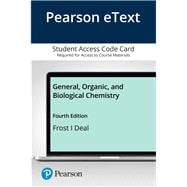An integrated and applied approach to General, Organic, and Biological Chemistry.
General, Organic, and Biological Chemistry strengthens the evidenced strategy of integrating general, organic, and biological chemistry for a focused introduction to the fundamental connections between chemistry and life. The streamlined approach establishes a clear path through the content over a single semester. The text integrates essential topics more effectively than any text on the market, covering core concepts in each discipline in just 12 comprehensive chapters.
With the 4th Edition, authors Laura Frost and Todd Deal apply their knowledge and experience in the science of learning to incorporate research and best practices based on how students learn. A stronger applied focus provides practical connections and applications, showing both allied-health and non-science majors how to use their understanding of chemistry in future health professions and in their everyday lives.
For courses in General, Organic, and Biological Chemistry (1 - Semester).
Pearson eText is an easy-to-use digital textbook that you can purchase on your own or instructors can assign for their course. The mobile app lets you keep on learning, no matter where your day takes you, even offline. You can also add highlights, bookmarks, and notes in your Pearson eText to study how you like.
NOTE: This ISBN is for the Pearson eText access card. Pearson eText is a fully digital delivery of Pearson content. Before purchasing, check that you have the correct ISBN. To register for and use Pearson eText, you may also need a course invite link, which your instructor will provide. Follow the instructions provided on the access card to learn more.












